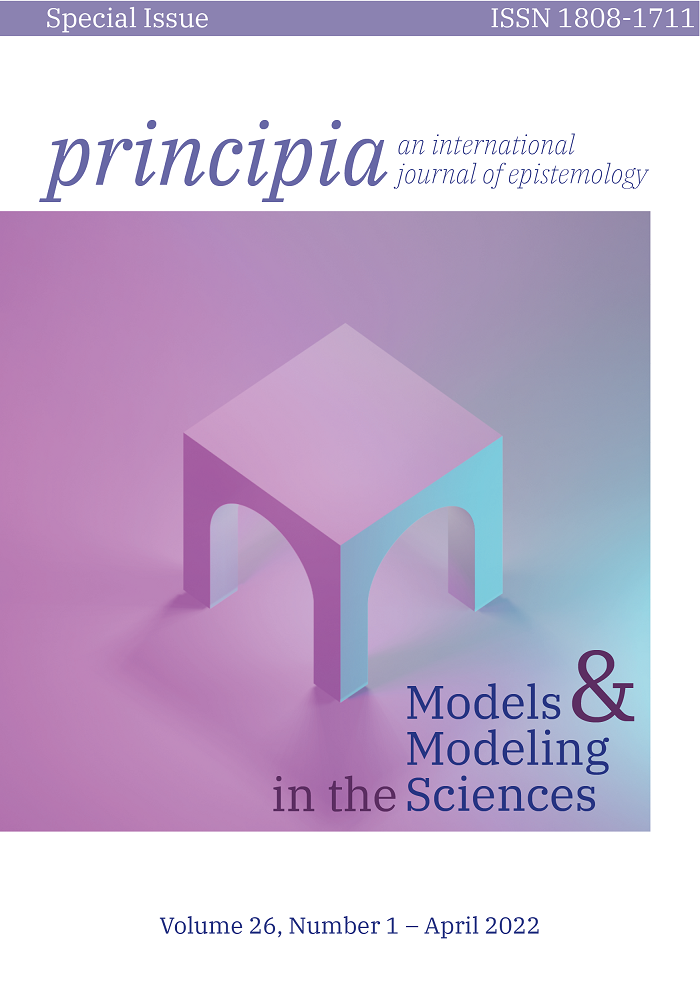What is the aim of models in formal epistemology?
DOI:
https://doi.org/10.5007/1808-1711.2022.e84677Palabras clave:
Belief, idealization, formal-epistemology, models, rationalityResumen
It is certainly well accepted that formal models play a key role in scientific job. Its use goes from natural sciences like physics and even to social sciences like economics and politics. Using mathematics allows the researcher to consider more complicated scenarios involving several variables. Some models are developed to make predictions, others to describe a phenomena, or just to improve the explanation of events in the world. But what has all this to do with philosophy? The aim of the present paper is to investigate debates on the role of formal models in a specific philosophical subject, precisely, the epistemology of rationality. Are we able to explain why models are needed in epistemological work? This answer will be addressed on the assumptions that epistemological theorizing is committed with normative statements. More specifically, epistemologists are concerned with normative questions about what rationality requires from epistemic agents. The first goal is to discuss some assumptions about the role of mathematical models in formal epistemology undertaking. And secondly, I will argue for the following two claims: (i) formal models are useful tools for predicting consequences of normative assumption about what is intuitively required by rationality; and (ii) insofar rationality theory is normative in virtue of being instrumentalist and aiming at truth, formal models are means-end tools, therefore, for rationality, mathematical models are devices for maximizing truth in doxastic states.
Citas
Alchourrón, C. E.; Gärdenfors, P.; Makinson, D. 1985. On the logic of theory change: Partial meet contraction and revision functions. Journal of symbolic logic, 50(2): 510–530.
Binmore, K. 1997. Rationality and Backward Induction. Journal of Economic Methodology, 4(1): p. 23-41.
Broome, J. 2013. Rationality Through Reasoning. Chichester: John Wiley & Sons.
Christensen, D. 2004. Putting logic in its place: Formal constraints on rational belief. New York: Oxford University Press.
Colyvan, M. 2013. Idealisations in normative models. Synthese, 190(8): p. 1337-1350.
Easwaran, K. 2016. Dr. Truthlove or: How I learned to stop worrying and love bayesian probabilities. Nôus, 50(4): p. 816-853.
Easwaran, K. & Fitelson, B. 2015. Accuracy, coherence, and evidence. In: T. Gendler (ed.), Oxford Studies in Epistemology, vol. 5, p. 61-96. Oxford: Oxford University Press.
Foley, R. 1992. The Epistemology of Belief and the Epistemology of Degrees of Belief. American Philosophical Quaterly, 29(0), p. 111–121.
Hansson, S. 2000. Formalization in philosophy. Bulletin of Symbolic Logic, 6(2), p. 162-175.
Harman, G. 1986. Change in view: Principles of reasoning. London: The MIT Press.
Hempel, C. 1962. Deductive-nomological vs. Statistical Explanation. In: H. F. Maxwell (ed.), Studies in the Philosophy of Science, pp. 98-169. Minnesota: University of Minnesota Press.
Hintikka, J. 1962. Knowledge and Belief: An Introduction to the Logic of the Two Notions. New York: Cornell University Press.
Huber, F. & Schmidt-Petri, C. (ed.). 2009. Degrees of belief. Dordrecht: Springer.
Joyce, J. M. 1998. A Nonpragmatic Vindication of Probabilism. Philosophy of science, 65(4): p. 575-603.
Genin, K. & Huber, F. 2021. Formal Representations of Belief. In: E. N. Zalta (ed.), The Stanford Encyclopedia of Philosophy. Fall 2021 Edition. https://plato.stanford.edu/archives/fall2021/entries/formal-belief/. Access: 31.10.2021
Kolodny, N. 2005. Why be rational?. Mind, 114(455): p. 509–563.
Kyburg, H. 1961. Probability and the Logic of Rational Belief. Middletown: Wesleyan University Press.
Leitgeb, H. 2017. The Stability of Belief: How Rational Belief Coheres with Probability. New York: Oxford University Press.
Lin, H. & Kelly, K. T. 2012. A geo-logical solution to the lottery paradox, with applications to conditional logic. Synthese, 186(2), p. 531–575.
Pettigrew, R. 2019. Epistemic Utility Arguments for Probabilism. In: E. N. Zalta (ed.), The Stanford Encyclopedia of Philosophy. Winter 2019 Edition. https://plato.stanford.edu/archives/win2019/entries/epistemic-utility/. Access: 31.10.2021.
Ramsey, F. P. 1980 [1926]. Truth and Probability. In: H. Kyburg & H. Smokier (ed.), Studies in subjective probability, p. 61–92. New York: Wiley.
Savage, L. J. 1972. The foundations of statistics. New York: Dover Publications.
Shafer, G. 1976. A Mathematical Theory of Evidence. Princeton, NJ: Princeton University Press.
Spohn, W. 2009. A Survey of Ranking Theory. In: F. Huber & C. Schmidt-Petri (ed.), Degrees of Belief, p. 185-228, Dordrecht: Springer.
Titelbaum, M. (forthcoming). Normative Modeling. In: J. Horvath (ed.), Methods in Analytic Philosophy: A Contemporary Reader. The PhilPapers Foundation.
Tversky, A. & Kahneman, D. 1983. Extensional versus intuitive reasoning: The conjunction fallacy in probability judgment. Psychological review, 90(4), p. 293-315.
Vineberg, S. 2016. Dutch Book Arguments. In: E. N. Zalta (ed.), The Stanford Encyclopedia of Philosophy. Spring 2016 Edition. https://plato.stanford.edu/archives/spr2016/entries/dutch-book/. Access: 31.10.2021.
Williamson, T. 2017. Model-building in philosophy. In: R. Blackford & D. Broderick (ed.), Philosophy’s future: The problem of philosophical progress, p. 159-172. Malden-MA: Wiley Blackwell.
Waltman, P. 2013. Deterministic threshold models in the theory of epidemics, Vol. 1. Springer Science & Business Media.
Wheeler, G. 2012. Formal Epistemology. In: A. Cullison (ed.), The Continuum companion to epistemology, p. 227-247. London: Bloomsbury Publishing.
Descargas
Publicado
Número
Sección
Licencia
Derechos de autor 2022 Matheus Rui

Esta obra está bajo una licencia internacional Creative Commons Atribución-NoComercial-SinDerivadas 4.0.

Principia http://www.periodicos.ufsc.br/index.php/principia/index is licenced under a Creative Commons - Atribuição-Uso Não-Comercial-Não a obras derivadas 3.0 Unported.
Base available in www.periodicos.ufsc.br.



